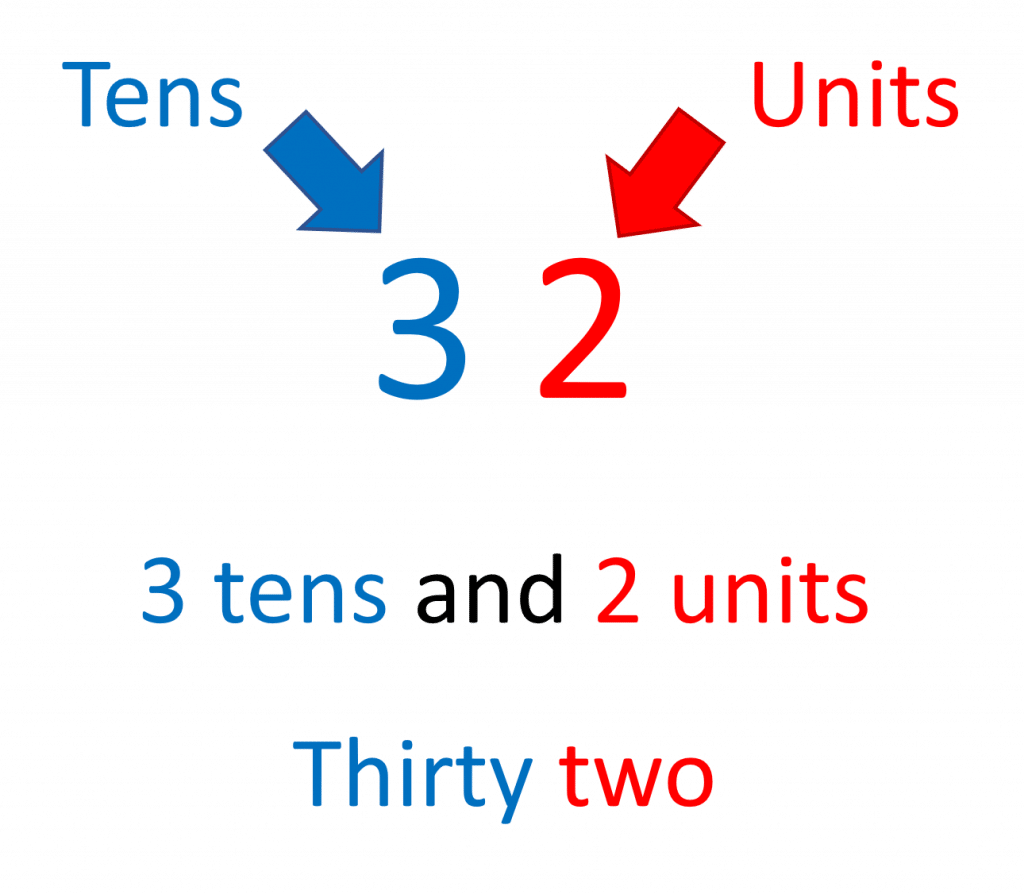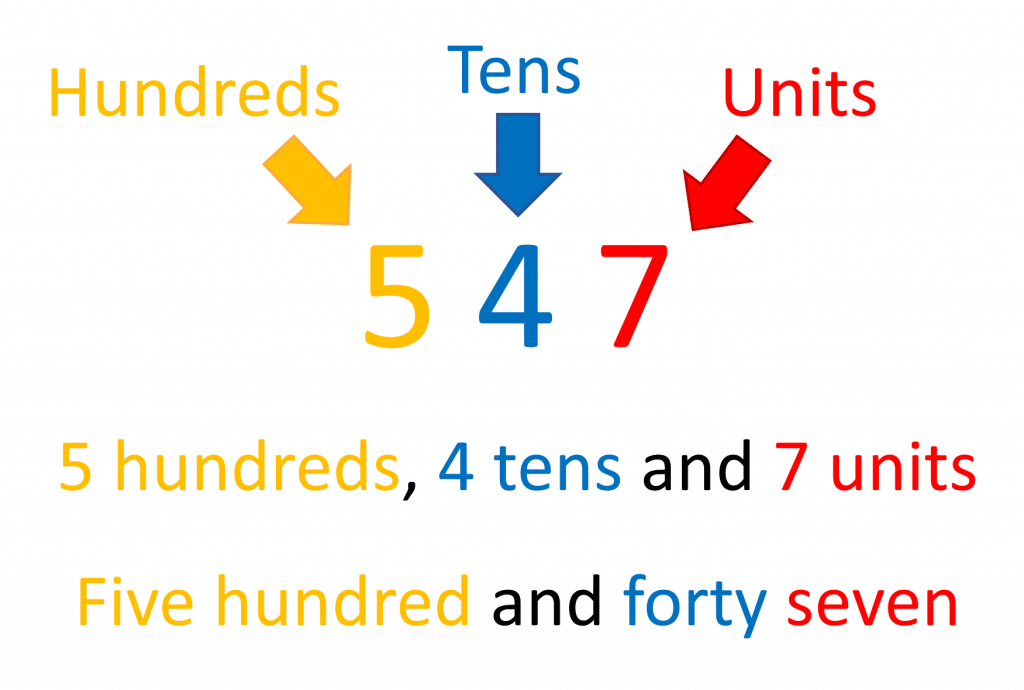Functional Skills: Number Basics
Number Basics
Numbers are made from putting digits together. A digit is one of 0 \,\, 1 \,\, 2 \,\, 3 \,\, 4 \,\, 5 \,\, 6 \,\, 7 \,\, 8 \,\, 9
e.g. 36, 783 or 458
Two-Digit and Three-Digit Numbers


Two-digit numbers are made up of tens and units (ones). The first digit of a two-digit number is the amount of tens the number has. The second digit of a two-digit number is the amount of units the number has.
For example, the number 32 can be split up into:


Three-digit numbers are made up of hundreds, tens and units (ones). The first digit of a three-digit number is the amount of hundreds the number has. The second digit of a three-digit number is the amount of tens the number has. The third digit of a three-digit number is the amount of units the number has.
For example, the number 547 can be split up into:
Follow Our Socials
Our Facebook page can put you in touch with other students of your course for revision and community support. Alternatively, you can find us on Instagram or TikTok where we're always sharing revision tips for all our courses.
Using the First Digit to find the Lowest and Highest Number
We can compare the first digits of different numbers to see which one is the lowest, or highest.
Example: Find the lowest number in the list:
172, 42, 220, 20, 59, 367
Step 1: Find the numbers with the least number of digits:
\textcolor{red}{4}2, \textcolor{red}{2}0 and \textcolor{red}{5}9 all have 2 digits
Step 2: Find the number with the smallest first digit:
\textcolor{orange}{20} is the smallest since \textcolor{red}{2} is the smallest from \textcolor{red}{4}, \textcolor{red}{2} and \textcolor{red}{5}
So, 20 is the lowest number.
Example: Find the highest number in the list:
172, 42, 220, 20, 59, 367
Step 1: Find the numbers with the most number of digits:
\textcolor{red}{1}72, \textcolor{red}{2}20 and \textcolor{red}{3}67 both have 3 digits
Step 2: Find the number with the biggest first digit:
\textcolor{orange}{367} is the biggest since \textcolor{red}{3} is the biggest from \textcolor{red}{1}, \textcolor{red}{2} and \textcolor{red}{3}
So, 367 is the highest number.
Using Other Digits to find the Lowest and Highest Number
If there are 2 or more numbers that have the same number of digits, and their first digit is the same, then you will need to compare the second digits.
The number that has the lowest second digit is the lowest, and the number with the highest second digit is the highest.
If the second digits are the same then you will need to compare the third digits and so on.
Example: James is 142 cm tall, Betty is 97 cm tall, Susie is 148 cm tall and Dylan is 88 cm tall.
Who is the tallest?
Step 1: Find the numbers with the most number of digits:
\textcolor{red}{1}\textcolor{blue}{4}\textcolor{limegreen}{2} cm and \textcolor{red}{1}\textcolor{blue}{4}\textcolor{limegreen}{8} cm
Step 2: Find the number with the biggest first digit:
They are both the same – \textcolor{red}{1}
Step 3: Find the number with the biggest second digit:
They are both the same – \textcolor{blue}{4}
Step 4: Find the number with the biggest third digit:
\textcolor{orange}{148} is the biggest since \textcolor{limegreen}{8} is bigger than \textcolor{limegreen}{2}
So, Susie is the tallest.
Ordering Numbers
Ordering numbers expands on what you have just learned.
Example: Jordan has 5 balls of different weight:
65 g, 4 g, 24 g, 183 g, 112 g
Put the balls in order of weight from smallest to largest.
Step 1: Put the weights into separate groups, starting with the numbers with the fewest digits:
1 digit: 4 g
2 digits: 65 g, 24 g
3 digits: 183 g, 112 g
Step 2: Put the numbers in order from smallest to largest within each group:
4 g, 24 g, 65 g 112 g, 183 g
Step 3: Write out the final order (put the numbers from step 2 together):
4 g, 24 g, 65 g, 112 g, 183 g
Functional Skills: Number Basics Example Questions
Question 1: Find the lowest number from the list:
14, 212, 25, 619, 47, 900
[1 mark]
The numbers with the fewest digits are:
14, 25, 47
The number with the smallest first digit is 14 since 1 is the smallest out of 1, 2 and 4.
So, 14 is the lowest number in the list.
Question 2: Find the highest number from the list:
24, 301, 28, 609, 9, 628
[1 mark]
The numbers with the most digits are:
301, 609, 628
The numbers with the largest first digit are:
609 and 628
Both numbers have a first digit of 6, so we will need to look at the second digit:
2 is bigger than 0, so 628 is the highest number.
Question 3: Adel has £328 cash, Bob has £5, Dara has £87, Kelvin has £125 and Rosie has £64.
Put the names of people in order from the person with the most cash to the person with the least cash.
[2 marks]
Put the cash values into groups with the same number of digits, with the ones with the most digits first:
£125, £328, £87, £64, £5
Put the numbers in each group in order from largest to smallest:
£328, £125, £87, £64, £5
Write out the final order:
£328, £125, £87, £64, £5
Specification Points Covered
EL3.1 – Count, read, write, order and compare numbers up to 1000







